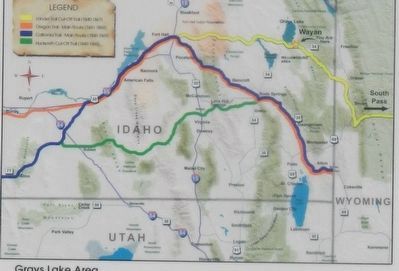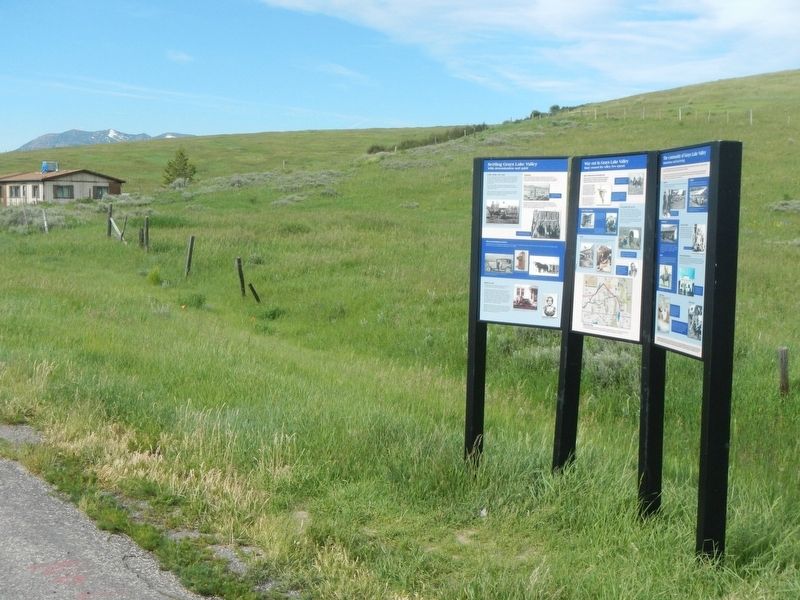Near Wayan in Caribou County, Idaho — The American West (Mountains)
Grays Lake Valley
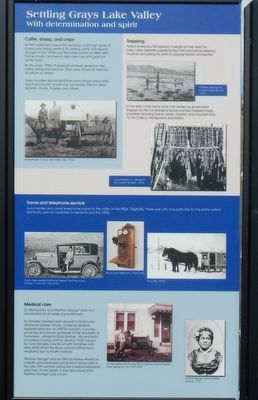
Photographed By Barry Swackhamer, June 21, 2017
1. Settling Grays Lake Valley, left panel
Captions: (cattle) Sheepherder in Grays Lake Valley, early 1900s.; (trapping, top & bottom) Children playing in a muskrat trapping boat, 1920s. Local trappers, C. Lyle Buton and Warren Petersen, 1930s.; (travel, l to r) Grays Valley resident Katherine Petersen and her young children in their late 1920s Ford. Hand crank telephone, 1920-1960s. Snow taxi, 1930s.; (medical) Dr. Ellis Kackley and his dog Pat at Caribou County Hospital, Soda Springs, ID., ca. 1935-1943. "Mother George," local midwife died ca. 1919.
With determination and spirit
By the early 1900s, thousands of sheep grazed in the valley during the summer. They were driven to warmer locations to winter.
Valley families descended from early sheep and cattle ranchers include: Linstroms, Lombards, Manns, Mults, Sibbets, Stoors, Tigeys, and others.
In the early 1930s some local men worked as government trappers for the U.S. Biological Survey and also trapped sheep predators including wolves, bears, coyotes, and mountain lions for the Caribou Woolgrowers Association.
Dr. Kackley traveled year around to Grays Lake whenever babies, bones, or serious ailments required attention. In 1898 Dr. Kackley, a young physician and recent graduate of the University of Tennessee, arrived in Soda Springs. He remained in Caribou County until his death in 1943. His son, Dr. Evan Kackley, practiced with his father until after WWII when the Navy veteran retired from medicine due to health reasons.
"Mother George: was an African-Native American midwife who lived and practiced in Grays Lake in the late 19th century during the Carriboo Mountain gold rush. At her death, it was discovered that "Mother George" was a man.
(center panel:)
Many crossed the valley. Few stayed
It was John Gray, a trapper from New York, and Scotch Iroquois leader who passed this way leaving his name to Grays Lake Valley, Grays Lake, and Greys
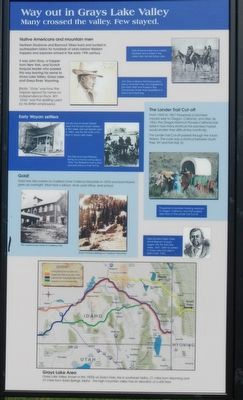
Photographed By Barry Swackhamer, June 21, 2017
2. Way out in Grays Lake Valley, center panel
Captions: (Native Americans) (l) John Gray, or Ignace Hatchiorauquasha, was a mountain man who trapped for the North West and Hudson's Bay Companies' Snake River Expeditions to Idaho and Wyoming. (r) Early Shoshone-Bannock Indians travelled and hunted in the valley later named Grays Lake.; (Wayan) (l) James and Amanda Sibbett were the first permanent settlers in the valley. Samuel Sibbett, born in 1883, was the first white child born in Grays Lake Valley. (r) The Otto and Nora Petersen family on a family outing about 1900. The Petersens had a store and postfix in their home.; (Lander Cut-off) (upper) Thousands of pioneers heading westward to Oregon, California and Utah passed near here on the Lander Trail Cut-off.; (lower) Early pioneer Green Flake drove Brigham Young's wagon into the Salt Lake Valley, 1847. Latter he settled in Grays Lake and died in Idaho Falls, 1903. (Gold) (l) The Greenhouse Hotel in Carriboo City. (r) Gold mining buildings on Carriboo Mountain.; (map) Grays Lake Valley, known in the 1800s as Gray's Hole, lies in southeast Idaho, 21 miles from Wyoming and 37 miles from Soda Springs, Idaho. The high mountain valley has an elevation of 6,400 feet.
(Note: "Gray" was how the trapper signed his name on Independence Rock, WY. "Grey" was the spelling used by his British employers.)
The Lander Trail Cut-off passed through the future Wayan. The routr was a shortcut between South Pass, WY and Fort Hall, ID.
(right panel:)
Industrious and fun-loving
For over 100 years, the Grays Lake Valley community has been and remains one of the last frontiers of rural America. It was one of the last places in the United States to enjoy indoor plumbing, telephones, and electricity.
Today, the northern part of the community is known as Grays Lake and the southern part as Wayan. Legend has it that the name Wayan was a derivative of the name Wayne and Ann Raymond who operated an early post office and store. Still others claim it came from "weigh Ann" a name local cowboys used to taunt the hefty lady.
Sawmills
Several sawmills operated in the valley. The Sornsen family had operated a sawmill in Wayan since the 1930s.
Dairies
Dairies operated by Kunz families rented cows for the summer and paid the owners in cheese.
Cheese Factory
The Grays Lake Swiss Cheese Factory started in the 1930s providing a market for milk from local farmers. It was operated by the Hirshbrunner family for three decades. Eventually, it was operated by Hans Baker and converted to a grocery store/gas station.
Rodeo
The annual Labor Day Grays Lake Rodeo was held for 33 years at the Ralph Stoor Ranch in Wayan. Locals showed off their roping, riding, and cooking skills. The event ended in 2010.
Grays Lake School
In the early years, the countryside was dotted with small one-room school houses. Community parties, dances, and even funerals were held at the Grays Lake School built
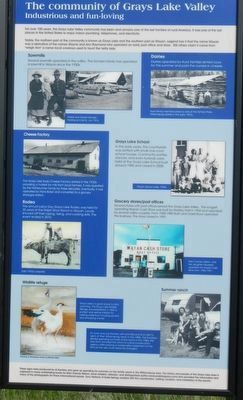
Photographed By Barry Swackhamer, June 21, 2017
4. The community of Grays Lake Valley, right panel
Captions: (sawmills, top left) Mattie and Garrett Sornsen holding son Earl Sr., ca. 1916,.; (dairies, top right) Kunz family members pose by one of the family's three Williamsburg diaries in the early 1900s.; (upper left center) Cheese Factory; (bottom left center, rodeo) Early 1940s cowpoke; (upper right center) Wayan School class, 1940s; (bottom right center) Ellen Carney Nelson and her daughter Maureen, operated the Wayan Cash Store from 1985-1991.; (bottom left) Wildlife refuge; Grays lake is a great place for bird watching. The Grays Lake Wildlife Refuge was established in 1965 to protect and restore habitat for nesting waterfowl including sandhill and whooping cranes.; (bottom right) Summer ranch; Dr. Evan and Lois Kackley with sons Ellis and Alvin (left to right) at their Williamsburg ranch in the 1950s. The Kackleys started spending summers at the ranch in the 1940s. Ellis and Alvin donated the ranch to a land conservation agency after placing a conservation easement on the land so the use could never be changed.
Grocery stores/post offices
Several stores with post offices served the Grays Lake Valley, The longest operating Wayan Cash Store was built by Stanley Huff in 1934 and operated by several valley couples. From 1950-1985 Ruth and Odell Stoor operated the business. The store closed in 1991.
Erected by Al Kackley.
Topics. This historical marker is listed in this topic list: Settlements & Settlers. A significant historical year for this entry is 1898.
Location. 42° 58.627′ N, 111° 22.63′ W. Marker is near Wayan, Idaho, in Caribou County. Marker is on Wayan Loop Road (State Highway 34) near Call Lane, on the right when traveling west. Touch for map. Marker is at or near this postal address: 3956 Wayan Loop Road, Wayan ID 83285, United States of America. Touch for directions.
Other nearby markers. At least 5 other markers are within 15 miles of this marker, measured as the crow flies. Cariboo Mountain (here, next to this marker); John Grey (within shouting distance of this marker); Henry-Chester Country Store (approx. 9.1 miles away); Tincup Creek (approx. 9.6 miles away); China Hat Geological Site (approx. 14.3 miles away).
Credits. This page was last revised on July 26, 2017. It was originally submitted on July 26, 2017, by Barry Swackhamer of Brentwood, California. This page has been viewed 810 times since then and 88 times this year. Photos: 1, 2, 3, 4, 5. submitted on July 26, 2017, by Barry Swackhamer of Brentwood, California.
